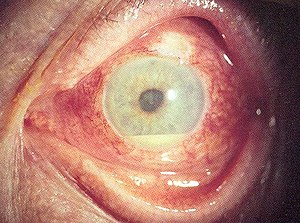Anterior uveitis
| Uveitis | |
|---|---|
 |
|
| Hypopyon in anterior uveitis, seen as yellowish exudate in lower part of anterior chamber of eye | |
| Classification and external resources | |
| Specialty | Ophthalmology |
| ICD-10 | H20 |
| ICD-9-CM | 364 |
| DiseasesDB | 13676 |
| MedlinePlus | 001005 |
| eMedicine | oph/580 emerg/284 |
| Patient UK | Uveitis |
| MeSH | D014605 |
Uveitis is the inflammation of the uvea, the pigmented layer that lies between the inner retina and the outer fibrous layer composed of the sclera and cornea. The uvea consists of the middle layer of pigmented vascular structures of the eye and includes the iris, ciliary body, and choroid. Uveitis is an ophthalmic emergency and requires a thorough examination by an optometrist or ophthalmologist and urgent treatment to control the inflammation.
Uveitis is classified anatomically into anterior, intermediate, posterior, and panuveitic forms—based on the part of the eye primarily affected. Prior to the twentieth century, uveitis was typically referred to in English as "ophthalmia."
Most common:
Intermediate uveitis normally only affects one eye. Less common is the presence of pain and photophobia.
Inflammation in the back of the eye is commonly characterized by:
Uveitis is usually an isolated illness, but can be associated with many other medical conditions.
In anterior uveitis, no associated condition or syndrome is found in approximately one-half of cases. However, anterior uveitis is often one of the syndromes associated with HLA-B27. Presence of this type of HLA allele has a relative risk of evolving this disease by approximately 15%.
The most common form of uveitis is acute anterior uveitis (AAU). It is most commonly associated with HLA-B27, which has important features: HLA-B27 AAU can be associated with ocular inflammation alone or in association with systemic disease. HLA-B27 AAU has characteristic clinical features including male preponderance, unilateral alternating acute onset, a non-granulomatous appearance, and frequent recurrences whereas HLA-B27 negative AAU has an equivalent male to female onset, bilateral chronic course, and more frequent granulomatous appearance. Rheumatoid arthritis is not uncommon in Asian countries as a significant association of uveitis.
Uveitis may be an immune response to fight an infection inside the eye. While representing the minority of patients with uveitis, such possible infections include:
...
Wikipedia
